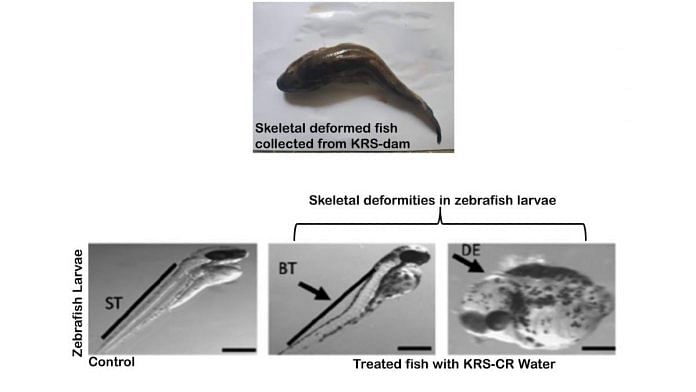Bengaluru: Microplastics and other pollutants may be causing growth defects and skeletal deformities in fish inhabiting the Cauvery river, a study led by researchers from Indian Institute of Science (IISc), Bengaluru, has found.
The Cauvery is the source of drinking water for humans and animals, as well as for irrigation in the states of Tamil Nadu and Karnataka. The study has been published in the journal Ecotoxicology and Environmental Safety.
The researchers analysed water samples from the river for levels of pollutants, and studied their microplastic composition. They then studied embryos of zebrafish incubated in these samples in the lab and found them to have growth and skeletal deformities, reduced heart rate, reduced life span, and DNA damage.
The damage was attributed to molecules called Reactive Oxygen Species (ROS), which are highly reactive chemicals derived from oxygen molecules, in the cells of the fish.
“The findings from the present study may prove helpful in providing valuable insights for future treatment of water and the potential health hazards of using KRS-CR water for drinking, fishing, and irrigation,” the authors conclude.
Also read: You may be breathing in a lot of microplastics, even at home
Hypoxic Cauvery waters
The Cauvery has been the dumping ground for many kinds of waste, including industrial and agricultural waste, which has led to indiscriminate pollution across the body of water.
The researchers sampled water from three kinds of stations — one where water was stagnant, one where it flowed slowly, and a third where there was rapid water flow. Analysis of these samples revealed the presence of multiple microorganisms that are bioindicators of the presence of pollutants — the first time this has been shown.
The team discovered that all chemical pollutants were within permissible safety levels, except for the quantity of dissolved oxygen, which fish breathe in, showing clear signs of hypoxic conditions or reduced oxygen.
Also present were microplastics, which have previously not been measured in Cauvery waters.
Microplastics today are found everywhere on earth, including in human bloodstream, in foetuses within pregnant women, inside plants, deep on the sea bed, in Antarctica, on top of Mount Everest, and in the air we breathe in daily. Sources of microplastics are plenty, including in our everyday use items such as clothes and water bottles.
In water, microplastics can enter into fish and other organisms, and in turn, pass higher up the food chain, even ending up on human plates. In animals, they can cause a range of damage to cells and DNA, affecting ecosystems across the world.
Hypoxia-induced cell toxicity
Initial analysis revealed that hypoxic conditions were found in both slow-flowing areas and stagnant samples.
For the study, the team filtered the water samples to remove chemical pollutants and accompanying microbes, and incubated zebrafish in them. They also did so in unfiltered water samples. They noticed that both before and after filtration, the fish developed various biological and genetic anomalies.
Hypoxic conditions generate molecules that are categorised as ROS. These include molecules like peroxides and free radicals like hydroxyl, which are derived from molecular oxygen. ROS molecules are unstable and react upon coming in contact with most substances. These molecules interfere with organelles in cells, causing toxicity, and leading to cell death and deformities.
The range of observed symptoms included DNA damage, reduced heart rate, build-up of fluid in the wall of the heart, death of cells, skeletal defects, lowered life span, and more.
Hypoxic conditions are induced by both microplastics, which break down, and by chemicals that are dumped into the water, putting marine organisms under oxidative stress or reduced ability to repair damage caused by ROS molecules. This in turn leads to a range of DNA and morphological defects.
(Edited by Nida Fatima Siddiqui)
Also read: India to the US — here’s why the world urgently needs a global treaty on plastic pollution



